A) effective price ceiling.
B) effective price floor.
C) efficient price ceiling.
D) efficient price floor.
Correct Answer

verified
Correct Answer
verified
Multiple Choice
Yulhee buys and wears a certain perfume because she likes its fragrance. Which statement describes externalities in the perfume market that come from individuals wearing perfume?
A) There may be positive externalities because others enjoy the scent, but there are no negative externalities.
B) There may be negative externalities because some may be allergic to the scent, but there are no positive externalities.
C) There may be both positive and negative externalities, since some enjoy the scent and some others have an allergic reaction to it.
D) There are no externalities associated with wearing perfume.
Correct Answer

verified
Correct Answer
verified
True/False
(Figure: Determining Surplus) In the graph, the formula for producer surplus is 0.5 × (i - j) × (k - i). 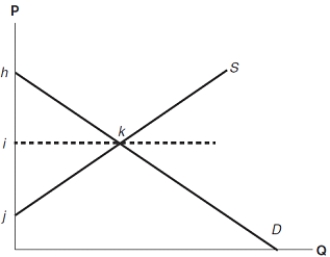
Correct Answer

verified
Correct Answer
verified
True/False
In theory, markets left alone should be competitive; however, when they are not, governments can promote competition in the marketplace.
Correct Answer

verified
Correct Answer
verified
Multiple Choice
(Figure: Determining Surplus 2) In the graph, the producer surplus is equal to _______. 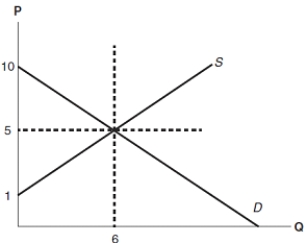
A) $12
B) $15
C) $25
D) $30
Correct Answer

verified
Correct Answer
verified
Multiple Choice
(Figure: Determining Surplus 3) In the graph, consumer surplus equals _______. 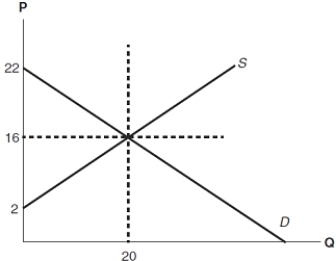
A) $30
B) $60
C) $140
D) $280
Correct Answer

verified
Correct Answer
verified
Multiple Choice
The gap between the supply curve and the market price is called:
A) consumer surplus.
B) deadweight loss.
C) markup.
D) producer surplus.
Correct Answer

verified
Correct Answer
verified
True/False
Price floors and price ceilings, although often inefficient, are an attempt by government to create equity or fairness in the market.
Correct Answer

verified
Correct Answer
verified
Multiple Choice
When markets are efficient:
A) the sum of consumer and producer surplus is minimized.
B) the sum of consumer and producer surplus is maximized.
C) consumer surplus is maximized, but producer surplus is minimized.
D) consumer surplus is minimized, but producer surplus is maximized.
Correct Answer

verified
Correct Answer
verified
Multiple Choice
The government often provides funding for the arts when markets do not do so sufficiently. This funding is to overcome which market failure?
A) asymmetric information
B) negative externality (external costs)
C) positive externality (external benefits)
D) public goods
Correct Answer

verified
Correct Answer
verified
Multiple Choice
If a city government were to impose a price ceiling to bring down rental prices of apartments in the downtown area:
A) quantity supplied would increase.
B) supply would increase.
C) an illegal rental market would likely emerge.
D) quantity demanded would decrease.
Correct Answer

verified
Correct Answer
verified
Multiple Choice
(Figure: Determining Surplus 2) In the graph, consumer surplus is equal to ________. 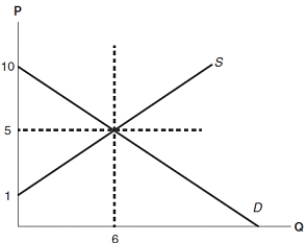
A) $15
B) $30
C) $54
D) $60
Correct Answer

verified
Correct Answer
verified
Multiple Choice
Suppose that the price of a good is $22 and equilibrium price is $18. Compared to market equilibrium:
A) consumer surplus is decreased and deadweight loss is increased.
B) consumer surplus is increased and deadweight loss is decreased.
C) producer surplus is decreased and deadweight loss is increased.
D) producer surplus is decreased and deadweight loss is decreased.
Correct Answer

verified
Correct Answer
verified
Multiple Choice
(Figure: Determining Surplus 3) In the graph, producer surplus equals __________. 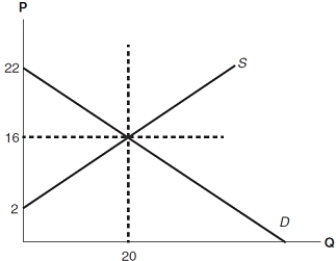
A) $60
B) $140
C) $160
D) $320
Correct Answer

verified
Correct Answer
verified
Multiple Choice
(Figure: Determining Total Surplus) In the graph, total producer surplus is shown by area: 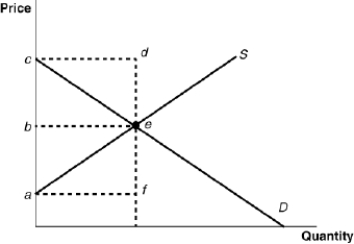
A) acdf.
B) ace.
C) bce.
D) abe.
Correct Answer

verified
Correct Answer
verified
True/False
At times, there are conflicts between market outcomes that are efficient and outcomes that society deems fair.
Correct Answer

verified
Correct Answer
verified
True/False
(Figure: Determining Surplus) In the graph, the triangle hik represents consumer surplus. 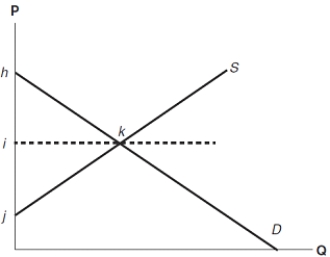
Correct Answer

verified
Correct Answer
verified
Multiple Choice
Suppose that a customer's willingness to pay for a product is $120, and the seller's willingness to sell is $110. If the negotiated price is $119:
A) consumer surplus is negative.
B) consumer surplus is greater than producer surplus.
C) producer surplus is negative.
D) producer surplus is greater than consumer surplus.
Correct Answer

verified
Correct Answer
verified
True/False
(Figure: Determining Surplus and Loss) In the graph, $8 would allow for an effective price ceiling. 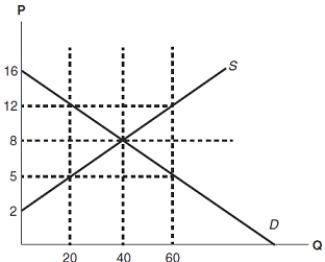
Correct Answer

verified
Correct Answer
verified
Multiple Choice
In the graph, if a price ceiling is set at $4, which of the following would result? 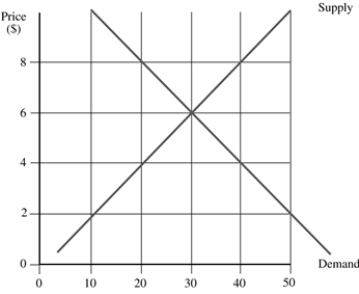
A) a surplus of 20 units
B) a surplus of 40 units
C) a shortage of 20 units
D) a shortage of 40 units
Correct Answer

verified
Correct Answer
verified
Showing 221 - 240 of 332
Related Exams